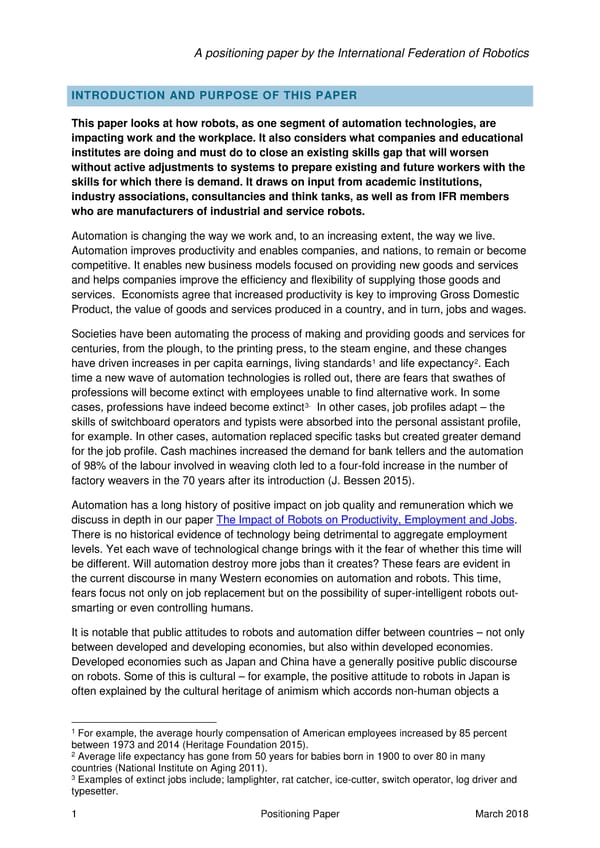A positioning paper by the International Federation of Robotics INTRODUCTION AND PURPOSE OF THIS PAPER This paper looks at how robots, as one segment of automation technologies, are impacting work and the workplace. It also considers what companies and educational institutes are doing and must do to close an existing skills gap that will worsen without active adjustments to systems to prepare existing and future workers with the skills for which there is demand. It draws on input from academic institutions, industry associations, consultancies and think tanks, as well as from IFR members who are manufacturers of industrial and service robots. Automation is changing the way we work and, to an increasing extent, the way we live. Automation improves productivity and enables companies, and nations, to remain or become competitive. It enables new business models focused on providing new goods and services and helps companies improve the efficiency and flexibility of supplying those goods and services. Economists agree that increased productivity is key to improving Gross Domestic Product, the value of goods and services produced in a country, and in turn, jobs and wages. Societies have been automating the process of making and providing goods and services for centuries, from the plough, to the printing press, to the steam engine, and these changes have driven increases in per capita earnings, living standards1 2 and life expectancy . Each time a new wave of automation technologies is rolled out, there are fears that swathes of professions will become extinct with employees unable to find alternative work. In some . cases, professions have indeed become extinct3 In other cases, job profiles adapt – the skills of switchboard operators and typists were absorbed into the personal assistant profile, for example. In other cases, automation replaced specific tasks but created greater demand for the job profile. Cash machines increased the demand for bank tellers and the automation of 98% of the labour involved in weaving cloth led to a four-fold increase in the number of factory weavers in the 70 years after its introduction (J. Bessen 2015). Automation has a long history of positive impact on job quality and remuneration which we discuss in depth in our paper The Impact of Robots on Productivity, Employment and Jobs. There is no historical evidence of technology being detrimental to aggregate employment levels. Yet each wave of technological change brings with it the fear of whether this time will be different. Will automation destroy more jobs than it creates? These fears are evident in the current discourse in many Western economies on automation and robots. This time, fears focus not only on job replacement but on the possibility of super-intelligent robots out- smarting or even controlling humans. It is notable that public attitudes to robots and automation differ between countries – not only between developed and developing economies, but also within developed economies. Developed economies such as Japan and China have a generally positive public discourse on robots. Some of this is cultural – for example, the positive attitude to robots in Japan is often explained by the cultural heritage of animism which accords non-human objects a 1 For example, the average hourly compensation of American employees increased by 85 percent between 1973 and 2014 (Heritage Foundation 2015). 2 Average life expectancy has gone from 50 years for babies born in 1900 to over 80 in many countries (National Institute on Aging 2011). 3 Examples of extinct jobs include; lamplighter, rat catcher, ice-cutter, switch operator, log driver and typesetter. 1 Positioning Paper March 2018
 Robots & the Workplace of the Future Page 1 Page 3
Robots & the Workplace of the Future Page 1 Page 3